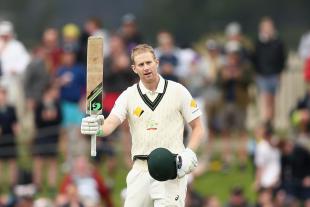Australia v West Indies, 2015-16

|
|||
|
Related Links
Tour and tournament reports : Australia v West Indies, 2015-16
Matches:
Australia v West Indies at Hobart
Series/Tournaments:
West Indies tour of Australia
Teams:
Australia
| West Indies
|
|||
At Hobart, December 10-12, 2015. Australia won by an innings and 212 runs. Toss: Australia.
Snow rested on top of Hobart's Mount Wellington on the third and final afternoon of the First Test. It felt appropriate, given the latest cold snap in Caribbean cricket's endless winter. Twelve West Indian wickets fell on the day to complete a hiding in half the allotted time. Every fear about the gulf between these teams had been realised.
Things began to unravel for the tourists from the moment the coin came down and Smith said: "We'll bat, mate." Holder admitted he would have bowled first on a pitch which was green on top but flat underneath. West Indies had talked up their fast bowlers, but both Taylor and Roach began with a no-ball, and Australia's openers rattled off 75 in 11 overs. There were 16 boundaries in the opening hour, and Warner raised his fifty from 40 deliveries.
But, to their credit, West Indies fought back to have Australia three down by lunch, with the key wickets of Warner and Smith falling to Jomel Warrican, a 23-year-old left-arm spinner playing only his second Test. This brought together Voges and Shaun Marsh. They had spent more than a decade at Western Australia longing to join forces at international level; now they made it count. Initially restrained, Voges broke free with four boundaries in an over from Warrican, using his feet to drive straight and his timing to flick to leg.
Feasting on the wayward Taylor, he made his third Test century a formality. It came at a run a ball - Hobart's fastest Test hundred - and was his most fluent innings for Australia. But Voges wasn't done yet. At the other end Marsh was content to watch and accumulate. Later, against the fast bowlers, he struck cover-drives so perfect you wondered why his talents had not reaped more. Marsh pulled Roach to the rope to raise his own third Test hundred, and his first at home. Voges' 150 came next, via a reverse sweep. By stumps Australia had amassed 438 for three, the most conceded in a day by West Indies.
Holder's problems had been compounded by an injury to Gabriel, who damaged his left ankle and arrived at the ground on crutches next morning. Voges flogged the rest of the attack, moving from his overnight 174 to an unbeaten 269 (a first-class best) by lunch, having faced 285 balls and hit 33 fours. By the time Marsh slog-swept Warrican to deep midwicket for 182 (also a first-class best), their alliance was worth 449 and had broken all sorts of records. It was the highest fourth-wicket stand in Tests (beating 437 between Mahela Jayawardene and Thilan Samaraweera for Sri Lanka against Pakistan at Karachi in 2008-09), the highest for any wicket in Australia (beating 405 between Sid Barnes and Don Bradman for the fifth, against England at Sydney in 1946-47), and the highest against West Indies (beating 411 between Peter May and Colin Cowdrey at Edgbaston in 1957). Only five other partnerships in Test history had yielded more. Over lunch, Voges - who had already surpassed Doug Walters's 242 at Sydney in 1968-69 as the highest score for Australia against West Indies - sportingly agreed to forego the chance of a triple-century, allowing Smith to declare and unleash his bowlers.
Hazlewood made the initial incision, but the wickets really started to tumble after Lyon came on. First he deceived Chandrika in the flight, then in a single over took a stunning return catch to dismiss Samuels, and had Blackwood snaffled at short leg for the first half of a pair. The collapse was in full swing when Siddle trapped Holder to make it 116 for six. All the while Bravo was showing the responsibility and class missing from the rest of the top order. At last he found support in Roach, and the pair nursed their side to 207 for six by the close. But, with Gabriel absent injured, it took Australia just five overs to wrap up the innings on the third morning, with Hazlewood leading the way. It was time enough for Bravo, ninth out, to reach his seventh Test hundred, including 20 boundaries, many of which crashed into the cover fence.
Pattinson, returning to the Test team after 21 injury-blighted months, had been wicketless and expensive. But, the follow-on enforced, there was a second chance against a wounded opponent. He responded with a burst of four wickets in his first four overs to set off an even more spectacular collapse, and finished with his joint-best Test figures of five for 27. Kraigg Brathwaite hit out with enterprise, but the mismatch was over when his
stumps were bent back by Hazlewood for 94 before tea on the third day, condemning West Indies to their heaviest defeat by Australia for almost 85 years.
Man of the Match: A. C. Voges

